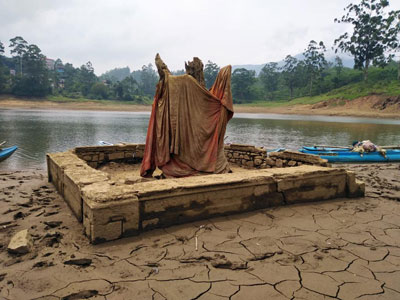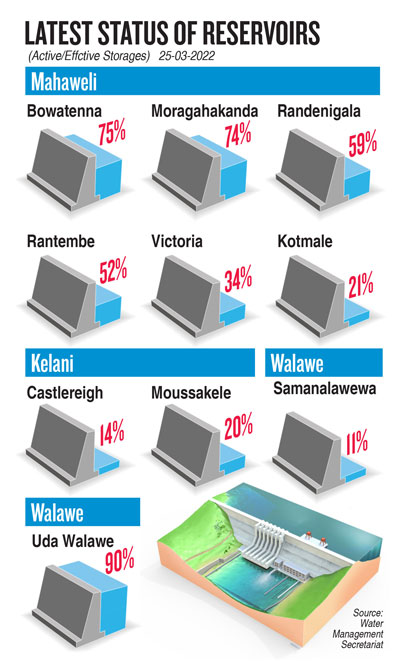News
Dire shortage of water looms as levels drop drastically in hydropower reservoirs
The rapid, continuous drop of levels in hydropower reservoirs could cause water scarcity and remaining reserves must be managed well at least till May, when rains are due.
Meanwhile, the dire shortage of water will further hamper power generation in the coming weeks. But reports of power cuts up to 10 hours next week were denied by the regulator, Public Utilities Commission of Sri Lanka, which said the Ceylon Petroleum Corporation had promised the required fuel to fire thermal-powered plants.

The old Kotmale town resurfaces as the water level drops in the reservoir
However, the inevitable decline of levels in reservoirs will curb crucial hydro-power generation. The drop in the three reservoirs mainly use for electricity production is rapid, exacerbated by prevailing dry weather.
The Water Supply Ministry is assessing the situation along with the CEB and may have to call for a restriction of hydropower generation to balance the water supply, Secretary of the Ministry Dr. Priyath Bandu Wickrama said.
“Last week, average inflow from the rivers to the reservoirs was about two-gigawatt hours but we are dispatching seven to 10-gigawatt hours per day,” Vidhura Ralapanawe, an energy analyst who has been monitoring the situation, said. “This means we have water left for around 35 to 50 days for hydropower generation.”
Castlereigh Reservoir, which feeds the Laxapana complex, had only 10.9 percent of its storage capacity left on Friday morning according to CEB data. And this could only generate 10.3-gigawatt hours.
The water level of Maussakelle Reservoir had also plummeted to 29.2 percent of its storage capacity. The remaining water volume can only generate 30.7-gigawatt hours of electricity.
 The water level at Samanala Wewa Reservoir was down to 13.6 percent of storage capacity, leaving only 18.1-gigawatt hours to generate.
The water level at Samanala Wewa Reservoir was down to 13.6 percent of storage capacity, leaving only 18.1-gigawatt hours to generate.
Out of CEB total storage capacity of 1,205-gigawatt hours, only 28.7 percent –a mere 346-gigawatt hours—remains. Such low levels have not been observed for this period of March in data for the past seven years, said Dr Ralapanawe.
While the Power Ministry has said arid weather is causing the depletion, he pointed out that several other preceding factors had also contributed.
The Lakvijaya Coal Power plant was knocked off from the countrywide blackout of December 3 last year, causing a premature and unexpected over-dependence on hydropower. “All three units were down due to the blackout and one unit didn’t start until February 2022,” he said. “We calculated the loss of coal power generation between December 3 and February 1 and it was 524-gigawatt hours.”
“Usually, rains end in November,” he continued. “Therefore coal power plants must operate at full capacity from December to the end of May.”
Chronic shortage of fuel for thermal power plants is also causing excessive use of hydropower. Separately, there has been a spike in electricity demand, despite power cuts, according to CEB data.
The Mahaweli Authority will not allow the overall water storage of the Mahaweli complex to drop below the specified threshold required for irrigation in mid to late April. These reservoirs are Kotmale, Victoria, Randenigala and Rantambe.
The best way to say that you found the home of your dreams is by finding it on Hitad.lk. We have listings for apartments for sale or rent in Sri Lanka, no matter what locale you're looking for! Whether you live in Colombo, Galle, Kandy, Matara, Jaffna and more - we've got them all!

